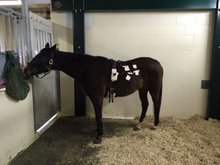Veterinary and engineering researchers at the University of Saskatchewan (U of S) have teamed up to harness imaging technology to fill in a blank area in animal health -- what goes on in a horse's gut?

Horse being diagnosed with camera pill endoscopy
The horse for the capsule endoscopy research is fitted with sensors and a data recorder for the approximately eight-hour test run..
© 2012 by University of Saskatchewan
"Whenever I talk to students about the horse abdomen, I put up a picture of a horse and put a big question mark in the middle," said veterinary researcher Dr. Julia Montgomery in the U of S Western College of Veterinary Medicine.
Montgomery worked with equine surgeon Dr. Joe Bracamonte and Khan Wahid, a specialist in health informatics and imaging in the College of Engineering. The team used an endoscopy capsule about the size and shape of a vitamin pill -- a sort of "mini submarine" with a camera -- to have a look inside a horse.
"This is really a cool way to look at the entire small intestine," Montgomery said, explaining the only other ways are exploratory surgery or laparoscopy, which uses a thin, lighted tube inserted through an incision. Neither allows a view from inside.
Veterinarians also can use an endoscope -- basically a camera on the end of a thin cable -- to look as far as the horse's stomach, and a rectal exam to have a look from the other end.
Montgomery explained that capsule endoscopy offers a powerful new tool to diagnose diseases such as inflammatory bowel disease and cancer, or to check surgical sites.
Researchers could use it to see how well drugs to stimulate bowel action are working, or to answer basic questions such as determining what "normal" small intestine function looks like.
Wahid has long worked with endoscopy capsule technology for humans and has even patented algorithms and data compression technology for their improved performance. The "camera pills" have been in use for human medicine for some time, he explained, but have yet to be applied in equine health.
"We thought, 'why not try it for veterinary medicine?'" Wahid said. On March 1, they did just that, administering the capsule through a stomach tube directly to the horse's stomach. For the next eight hours, the capsule and its camera made its way through the horse's small intestine, offering a continuous picture of what was going on inside.
The team plans to run more tests in the next few months on different horses to gather more data. With this in hand, they plan to pursue funding to further develop equine capsule endoscopy.
"From the engineering side, we can now look at good data," Wahid explained. "Once we know more about the requirements, we can make it really customizable, a pill specific to the horse."
